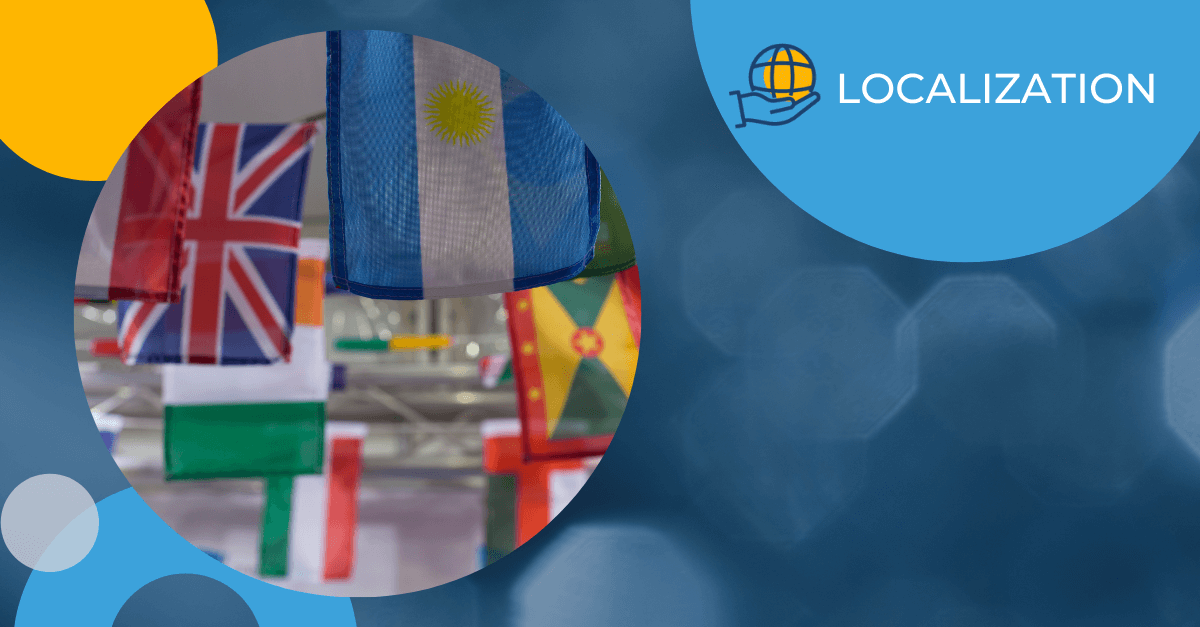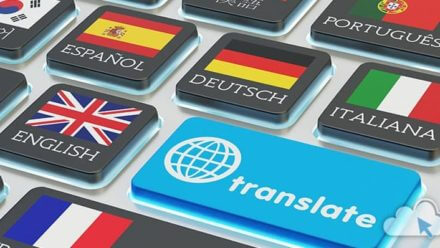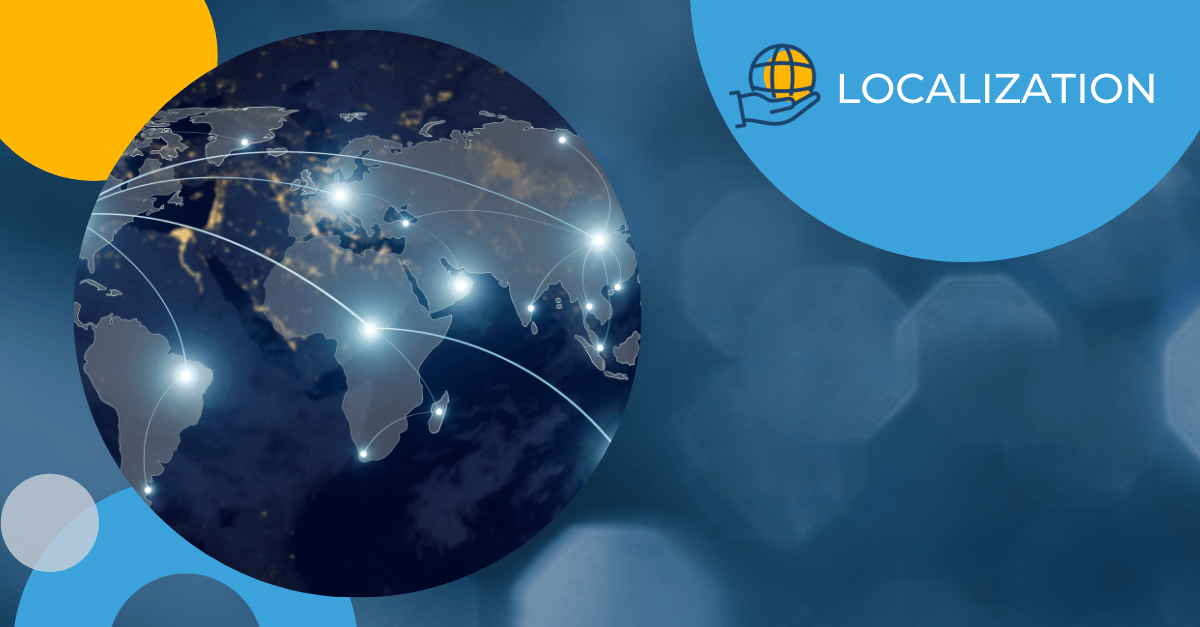Tag: localization
Localization, Internationalization, and Globalization: An Overview

Many individuals and companies think the process of translation is a simple one. Take the text or content in one language, have a translator translate it into another language, and voila! –you now have a multilingual version of your original. Sounds simple, right? The reality, of course, is more complex than that, especially for businesses with the goal of translating for multiple markets.
What is Localization?
The term ‘localization’ is oftentimes used synonymously with ‘translation’. They are, however, different in several respects. Whereas translation is typically used as a catchall phrase for taking text from one language and converting it into another, localization refers to the adaptation of content not only to the target language, but also to that target language’s culture and style.
When content goes through the localization process, some of the atypical items that must also be accounted for can include:
- Date and time formats
- Currency
- Language direction
- Capitalization rules
- Grammar rules
- Symbols and icons
- Country-specific legal formatting
- Culturally appropriate text, graphics, references, etc.
This can be an enormously complex and time-consuming process—depending on the scale of the project. Culture, in and of itself, can be hard to define and more often than not, colloquialisms in one particular culture do not lend themselves to the same meaning in another. Simply translating the words will do little to convey the original meaning of the text and can cause more confusion than clarity in the final translation.
What is Internationalization?
While localization is the process of adapting content into another language and culture, internationalization is the process that enables localization to be carried out effectively. For instance, if a company wishes to localize a particular software program, website or app, internationalization enables
the software to properly handle the necessary character encodings and language variants. This usually involves separating localizable elements from the source code or original content so that the end-user can select the localized text based on their language preferences.
During the internationalization process, all of the items that require localization (date and time formats, currency, language direction, etc.) must be accounted for ahead of time, and various character lengths within the program must be adjusted. More often than not, when text is translated into another language, the length of the text can vary drastically. For example, translating from English into French will most likely result in much longer text than the original source text, whereas translating into Chinese (a symbol-based language) will result in much shorter text.
With proper internationalization, the localized content will adjust accordingly for each language to ensure that the text remains properly formatted within the document or program. Attempting to retrofit a localized product after the fact is a much more difficult and time-consuming process, especially when there are multiple items and multiple languages to account for. That is why internationalization must be planned early to avoid the trouble and expense of making changes later on.
What is Globalization?
Globalization is simply the umbrella term used to describe this internationalization and localization process. Most of us are familiar with phrase, “going global” when it comes to business. In essence, it means taking your product or service to foreign markets all over the world by adapting to cultural differences, language, units of measure, etc.
Through globalization, a business utilizes the processes of internationalization and localization to ensure they can effectively cater to a particular region with linguistically and culturally appropriate material.
For businesses that are truly looking to make their products relevant in the global market, the translation process should never be an afterthought. It should ideally be planned ahead of time and incorporated into the planned rollout of the product.
If you want to learn more about our professional localization services, contact us here.
Get the latest insights delivered to your inbox
Tips for Setting up Your Multilingual Website

The internet has become the primary method of communicating in the global economy and enabling cross-border commerce at an unprecedented level – making website translation an even greater priority. Research shows that even though English is the most commonly used language on the web, 75% of internet usage is in another language. Based on data from consumers in these non-English speaking markets, 52.4% said they wouldn’t buy from a website which is not in their native language. Additionally, 72.1% of international customers spend the majority of their time on sites in their own language. These statistics are a clear indication that in order to reach foreign audiences, you need to speak their language. Translating your website is a must, but before setting up your multilingual website, here are 3 important tips to consider:
- Domain Structure
When setting up your multilingual website, it is important to identify the URL structure for the different languages. There are several different methods you can try. The first, and most common, is to use country code top level domains. For example Amazon uses Amazon.de for Germany, and Amazon.co.uk for UK. The benefits of using country code top level domains is that you can target your audience in specific regions arounds the world.
The other option is creating separate sub domains for each language. For example, de.hello.com for Germany or us.hello.com for the US. The advantages of using separate sub domains is you can have a separate Google Webmaster Tools for each sub domain – which allows you to set geo-targeting. Geo-targeting allows you to determine the locations of a specific user and deliver specific content based on each user’s location.
The last way to structure your domain is putting the languages in a Sub Directory, for example www.hello.com/de. You can use webmaster tools for geo-targeting with this option as well.
We recommend using the country code top level domain to structure a multilingual website because having a local domain makes it easier for your site to come up in searches and vastly increases your discoverability in new markets.
- Keyword Localization
Incorporating the correct keywords on your website is critical for showing up in Google searches. Because keywords are highly determined by the culture and can vary greatly across regions, it is important to localize the keywords as opposed to just literally translating them. For example, most Americans will type in “pants” when searching for clothing, but customers in the UK would use “trousers”. Understanding these differences will help dictate what words should be present in your website’s content.
Researching and finding the correct keywords can be very time consuming, but your SEO efforts in foreign markets will have little hope of success without these efforts. If you are going to outsource this type of project, make sure that you’re Translations Company or SEO agency understands the importance of keyword research and can properly maximize this critical component in your target markets.
- General Website Layout and Design
The colors, images, and graphic content on your site can all play a big role when creating a multilingual website, impacting perceptions in specific markets. Make sure the graphics you use are culturally relevant and that there is no text embedded in any of the pictures. Also, be careful of symbols and icons that are used as each symbol can have drastically different connotations across cultures. Another thing that can be easily be overlooked are currencies, dates and units of measure. Make sure that each is localized and fits the specific region.
It is also important to keep in mind the direction in which your audience reads. For example, Arabic is read from left to right. Knowing this will most likely affect the positioning and layout of your website.
Your website is often your first point of interaction with a new customer and effective website translation & localization is key to ensuring a positive first impression and repeat business from global consumers.
Get the latest insights delivered to your inbox
Is Your Website Still Only in English?

Localization is about more than just entering a new market – it is about embracing the unique elements that make that unique market special and important. When a business engages an audience on a level that places its specific context at the forefront, they are showing a commitment to building the foundation necessary to provide the highest quality service or product for that market. When a business treats its new market like an afterthought, it can be sure that this market will reciprocate in kind.
Today, the internet has become the primary method of communication in the global economy, enabling cross-border connections at an unprecedented level and making localization an even greater priority. Research shows that 52.4% of foreign market consumers won’t buy from websites that are not in their language[1], and 72.1% of international customers spend most of their time on sites in their own language[2]. Even people who feel comfortable in the English language prefer to buy in their own language. 90% of Japanese respondents, 74% of French-speaking Canadians, 79.5% of Germans, 82.5% of Italians, 65% of Dutch respondents would rather buy in their native language[3].
These numbers reflect a wider trend where consumers worldwide are increasingly expecting a higher degree of personalization. It isn’t just about the ease of use, though this is certainly a key factor. Having the information in the language that a user speaks tells each customer that they are important and valuable to the brand. When you don’t take the time to translate your site, you are inherently saying that these languages and the markets where these languages are predominantly spoken are of lesser importance to you. A customer that feels that they are of lesser importance, is certainly less likely to utilize your service or buy your product. Customer satisfaction is key to successful business which is why Morningside puts a key emphasis on localization.
Despite our increasingly interconnected world, language remains a significant obstacle when trying to reach an international audience with your website. To achieve a true global reach, the largest and most successful companies are translating their website into multiple languages and localizing their message to each specific target audience. The bottom line is if your website is still in English only, make 2015 the year that you take your product or service global.
Get the latest insights delivered to your inbox
5 Steps to Ensure a Successful Translation

When you’re planning an entry into a new market, translating your documents may seem like the least of your concerns. Yet, a poorly translated project can harm your company’s perceived professionalism, negatively impact the message they are trying to get across and handicap an otherwise brilliant new market strategy.
Here are 5 steps you can take to ensure your translation process runs smoothly.
1. Provide Enough Time
Time is everything, and whether you are tackling document translation, patent translation, medical translation, or website localization, it is important to give yourself enough time to perfect it. You want to make sure that the translator or translation company has enough time to thoroughly research the subject matter, prepare the translation, and revise and proofread until the final draft is perfect.
The Project Manager at Morningside, says that “Collaboration is key, the more time you have with your translator the more likely you’ll be on the same page. Effective teamwork and communication is one of the keys to localization and translation success.”
Tip: If you know that you will need a translation done and you want to reach out to a professional translation company, speak with them as early as possible so that they can build a custom workflow for your project and find the ideal translator for your project.
2. Create a translation glossary and style guide.
A translation glossary and style guide are helpful cheat sheets for linguists to better understand your company. A translation glossary includes the companies “lingo”, words that should stay consistent throughout, and words that should not be translated such as product names. A style guide describes how a company should be presented visually and textually and the overall style and tone of the company. In short, it identifies those branding elements that must remain, no matter the locale. Providing both a translation glossary and style guide to linguists can help ensure consistency. Without this, words and phrases can be translated in multiple ways across different languages meaning more time spent revising translations to create consistency. A Glossary and style guide can not only help with consistency, but it can also reduce the length of time it takes to complete each document translation and cut costs.
3. Don’t use Multiple Linguists
You might think that using many linguists for large projects will speed up the process, but it could have a negative impact on the overall quality and cohesion of the project. Why is that? The more linguists involved, the more prone you’ll be to inconsistencies in the translation. Beyond the specific style and tone of each linguist, many words have multiple translations that could fit in a given language and consistency is key when delivering a message and building a brand. This is especially true if you want to keep with a specific and notable brand image or content style used in the past. The same also applies to your proofreader – give one person enough time as opposed to forcing the issue with multiple people.
The caveat to this idea is getting a fresh set of eyes on a longer project. Once you’ve completed a translation, give one person with fresh eyes the chance to look it over and check for mistakes.
4. Provide as much detail as possible.
The more information you can provide to your translator or translation company, the better. Besides including more details in the translation, it gives the translation service a more accurate ability to choose a translator that has the expertise in that specific field.
5. Translation memory tools.
Translation memory tools are able to store segments, such as sentences, titles, headings, and phrases and create a database for future projects. This helps save time and money for any updates that need to be done to a project, or for translating any new content. It enforces consistency throughout all versions of any projects and also cuts time because the linguists don’t have to spend time re-translating the same thing time and time again. Morningside Translations currently works with both MemoQ and SDL Trados Studio which has helped reduce client costs tremendously.
A high-quality translation is a key part of bringing your product or service to a new market, and a poorly executed translation can cost you business. By following the above tips, you can improve the quality of your translation, lower costs and help make your entry into new markets an easier process.
Get the latest insights delivered to your inbox
The Temptation of Using Distributors for Translation Needs

When a manufacturer sells their products in foreign markets, localizing documents becomes a necessity in most cases. There may be anything from product manuals, to marketing materials, or even packaging labels which need to be localized. This can be a daunting task, especially for companies not familiar with the localization process. For this reason, some manufacturers simply rely on their local distributors to deal with translating the various documents. After all, the distributor is already responsible for selling the products, so surely they can handle translating any documents. Manufacturers often feel this solution will save them time, money, and other resources. While this may appear to be a simple solution for the short term, it’s not necessarily the best option for the long term.
There may be certain situations where relying on the distributor for translation is perfectly fine. However, there are a few things to consider before making this decision.
Legal Liability & Quality Standards: If there is a mistake or incorrect translation, what will be the liability of the manufacturer? Keep in mind, the distributor is responsible for selling many products from many manufacturers, and translation is simply not their top priority. The distributor may not be as concerned as the manufacturer about the quality of the translation or any legal liability that could result from a lack in quality.
Consistency & Brand Identity: Many manufacturers invest lots of time, money, and thought, to establish a certain brand identity and positioning for their products. Carrying this over to foreign markets requires a central translation and localization effort. In many cases, the manufacturer may be using multiple distributors, which means there’s no way to control the consistency of translation, and certainly no way to maintain the brand identity in each foreign market.
Distributors simply don’t have the same interests as the manufacturer when it comes to how the products are represented. Therefore, they can’t be expected to be as concerned about the quality of translation. Unfortunately, this can mean brand identity won’t carry over, translations may be inconsistent, and possibly exposure of liability. If, however, a manufacturer invests in translating and localizing the various documents, it can pay off significantly. If a high quality translation partner such as Morningside Translations is used, the brand identity will be properly localized and the materials will be consistent in foreign markets, all of which will result in more sales in the long run.
Get the latest insights delivered to your inbox
Helping Your Localized Website Translate

Website translation is extremely important for companies who wish to reach foreign markets and expand national trade. Translation can easily be done by copying and pasting your website into a free literal translation service online, but will it accurately explain your company? Beyond the obvious risk of grammatical errors impacting your perceived professionalism, neglecting the importance of cultural cues can be the difference between a website that succeeds and one that just doesn’t translate.
Enter website localization.
Website localization takes the translation process a step further by accounting for the particularities of a given target market. There are professional website translation and interpretation services who understand the importance of these nuances when relating to international customers, and they can do wonders for companies looking to expand globally. However, whether you choose to do it yourself, or you want to better interact with an outsourced provider, there are a few things to keep in mind.
Pick The Right Language:
Research shows that 52.4% of Foreign Market Consumers won’t buy from websites not in their language[1] and 72.1% of international customers spend most of the time on sites in their own language[2]. The good news is that 90% of online business is done in only 13 languages. The bad news is that if you choose the wrong one, you’re chances of penetrating that market are significantly reduced.
Few business people would enter a new country without taking the time to research the potential benefits its market offered. You may look at the hold competitors have, the size of the addressable market, or the amount spent on similar products. But just as important as knowing whether there are people who could potentially buy your product, is knowing how best to sell it to them. The first step in this process is knowing which language that industry speaks. Research the country you’re entering and see what language dominates the sector you’re trying to enter. Many countries are filled with a multitude of spoken languages, but there are generally a select few used in the business world. Knowing these in advance will make sure your efforts to localize aren’t in vain.
Correct Keywords:
Incorporating the correct keywords on your website is critical for SEO and has a major impact on localization success. Keywords are highly determined by the culture and can vary greatly across regions. For example, most Americans will type in “Vacation” when searching for a resort, but customers in the UK would use “Holiday”. Understanding these differences will help dictate what words should be present in your website’s content.
Keyword research can be a painstaking process, but you’ll have little hope of succeeding without investing in it. If you are going to outsource this type of project, make sure that your provider understands the importance of Keyword research and has the capabilities to properly maximize this critical component.
General Website Layout:
The colors, images, and graphic content can all play a big role in website localization and how it is perceived by that foreign market. Make sure the graphics you use are culturally relevant and that you don’t have any existing materials that may be insensitive or offensive. It’s important to remember that many symbols are used across cultures, but can have drastically different connotations.
Color is another important factor to consider because it can have different meanings or associations. For example, in China white is the color of death and mourning, whereas the same is symbolized by purple in Brazil. Yellow represents sadness in Greece, jealousy in France, but means sacred to the Hindus.
Also, it is important to consider the direction in which your audience reads, depending on their language–whether it be from left to right, right to left, or top to bottom–as this will most likely affect the positioning and layout of your website.
Website translation will be a critical component to your localization efforts, but in order to maximize this opportunity you must consider its full impact. If you hire an interpretation service, make sure they are aware of these issues. If you decide to handle it internally, considering these factors can be the difference between a major victory or a missed opportunity.
Get the latest insights delivered to your inbox
Importance of Localization

We came across this interesting infographic at Wired Magazine the other day, highlighting a number of websites throughout the world that have a bigger local foothold than their globally popular American equivalents:
http://www.wired.com/magazine/2012/02/st_internetoutliers/
Take Rakuten’s dominance in Japan for example. Amazon has successfully expanded on a global level, but Rakuten, by offering services, products, and a format specific to Japan, has been able to successfully capture a third of a $30 billion market.1
This underscores the importance of the localization aspect of translation services in expanding your business beyond the borders of your home country. Simply translating the words of your website or white papers into a foreign language is not sufficient in building your brand abroad. You must ensure that the translator is a native of the target country, so as to be knowledgeable about local cultural idiosyncrasies and be capable of expressing your meticulously worded documents in a way that speaks to the local population. For example, if your document included the idiom “I have other fish to fry”, a Francophone might be confused to read the direct translation of “j’ai d’autres poissons à faire frire”; the French equivalent is “j’ai d’autres chats à fouetter”, or “I have other cats to whip” (it would appear between the English “there is more than one way to skin a cat” and this one, felines can’t catch a break when it comes to idioms!)
Localization is an essential component in ensuring that your translation has the maximum effect in the target market. At Morningside, translators for projects involving localization are selected not only on the basis of their expertise in the appropriate field, but also their mother tongue and local knowledge. After all, you wouldn’t want to appear to be an octopus in a garage (Spanish equivalent of “fish out of water”)!
1. http://www.economist.com/node/16322651 [Retrieved 05/01/12]

